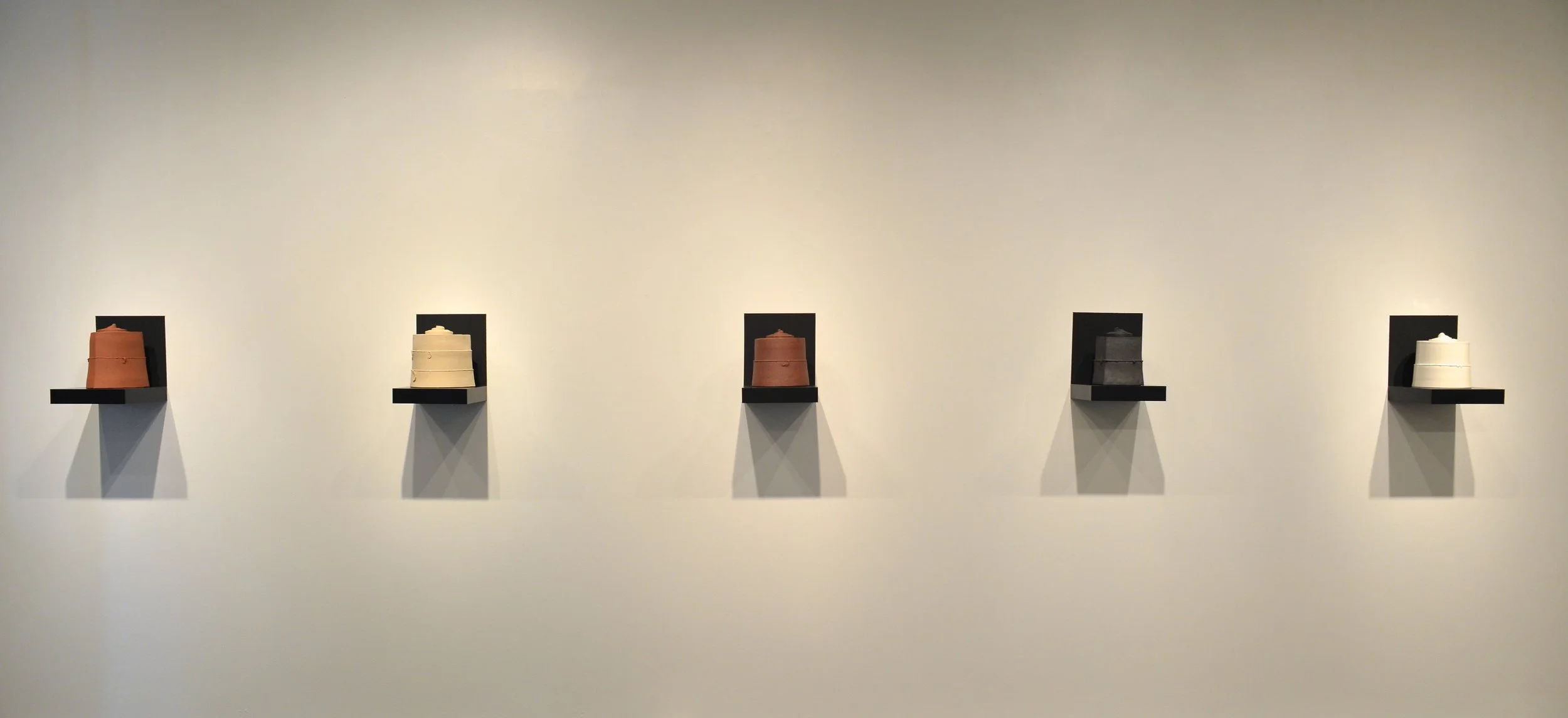





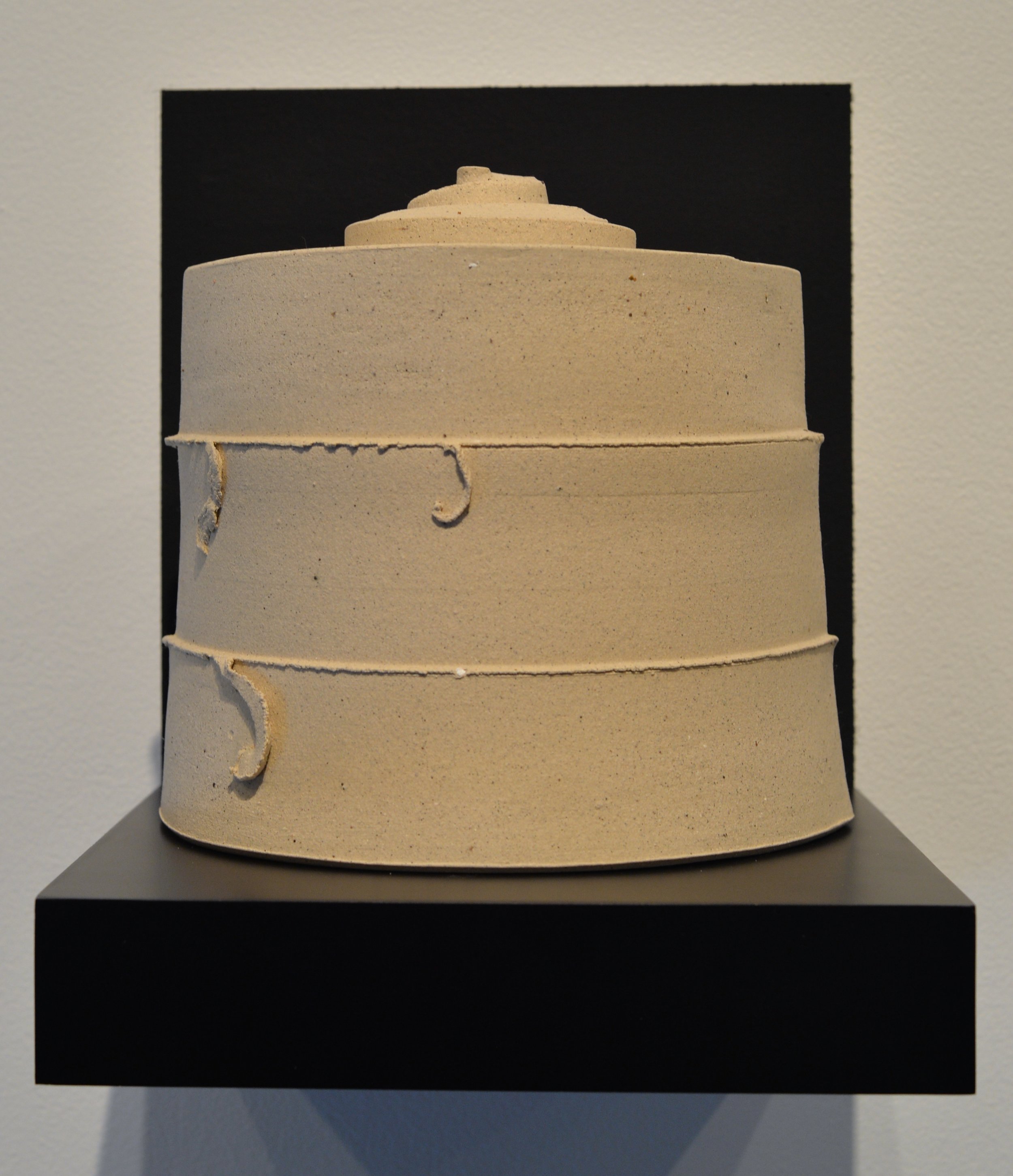

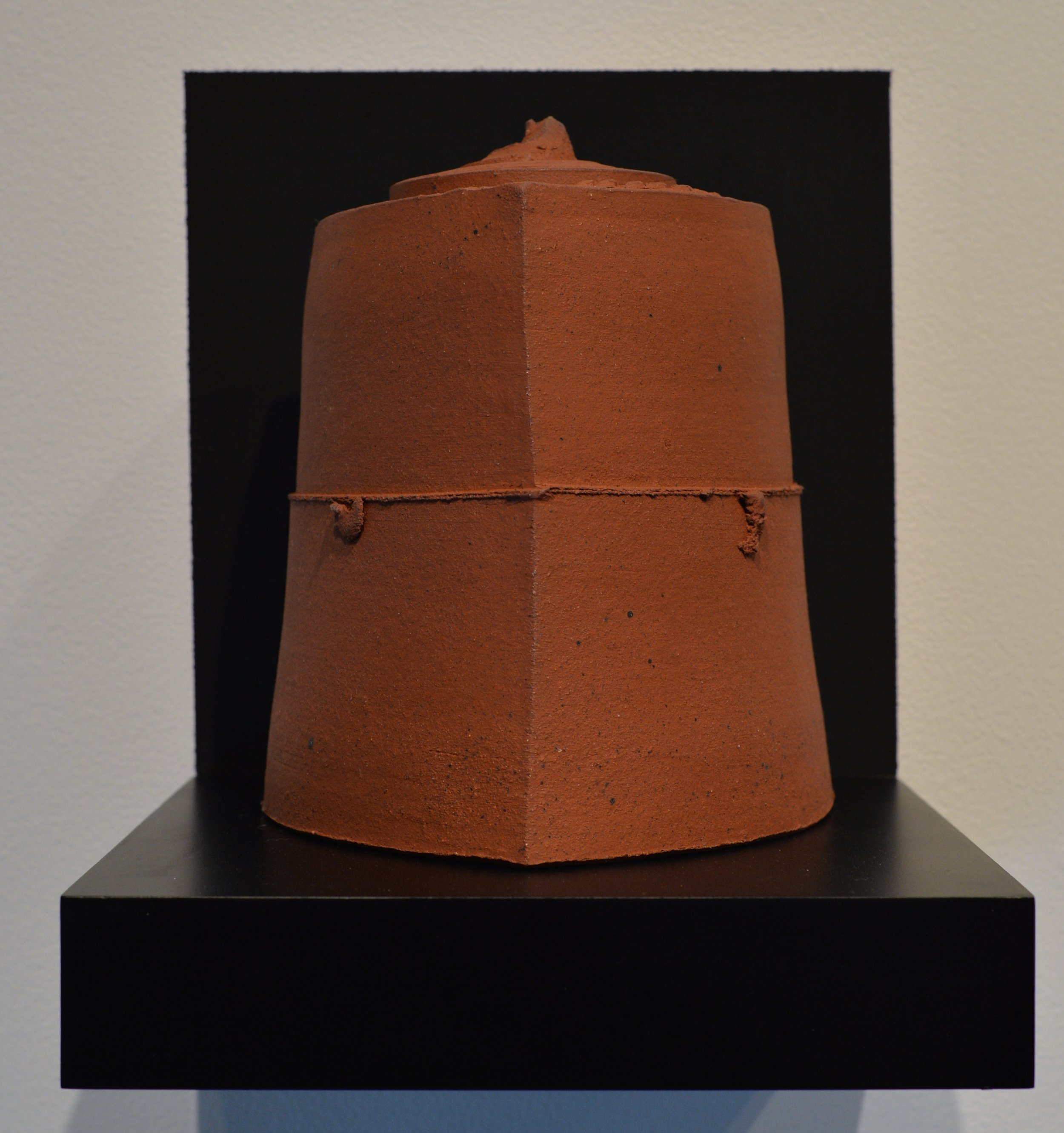

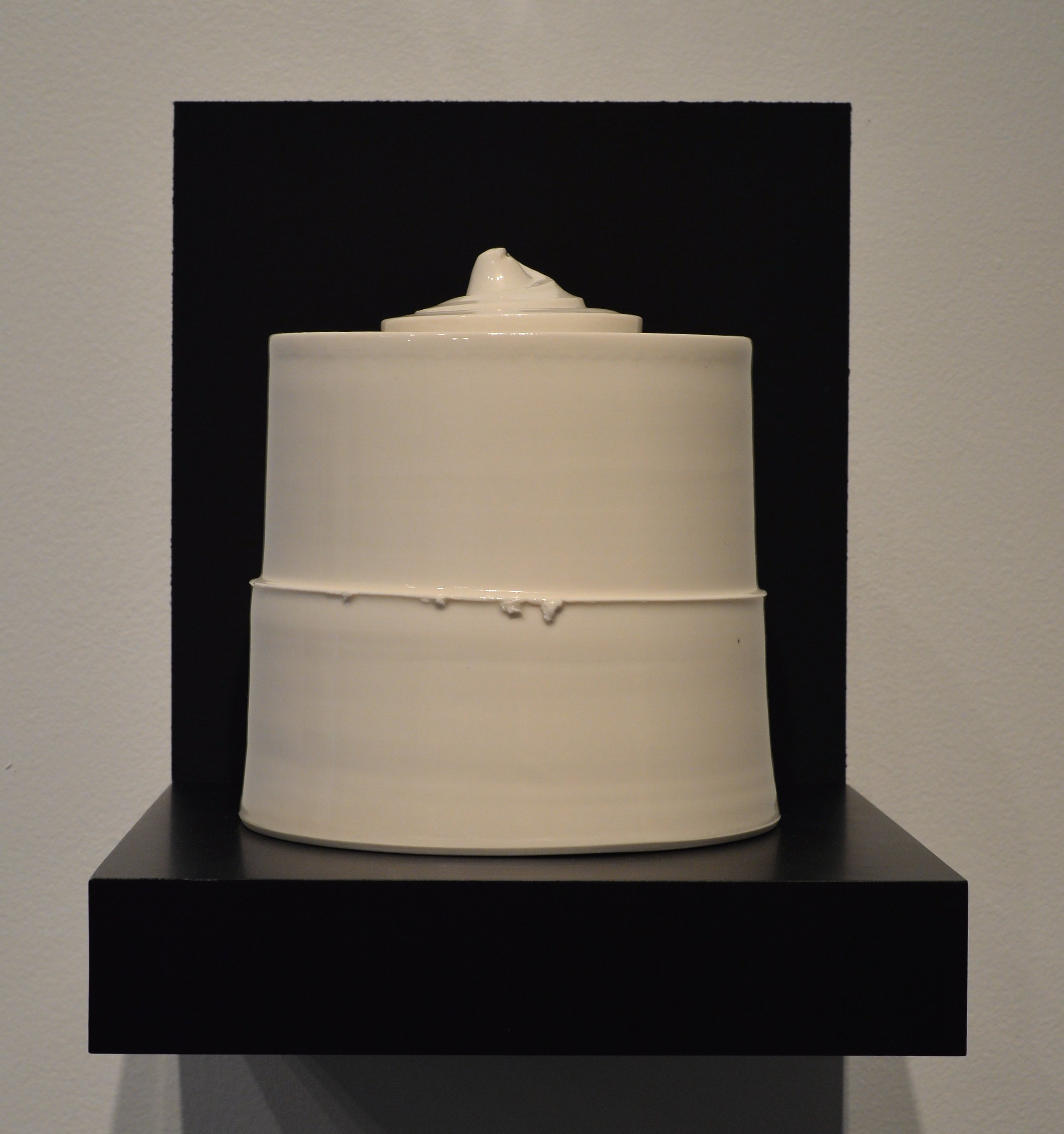



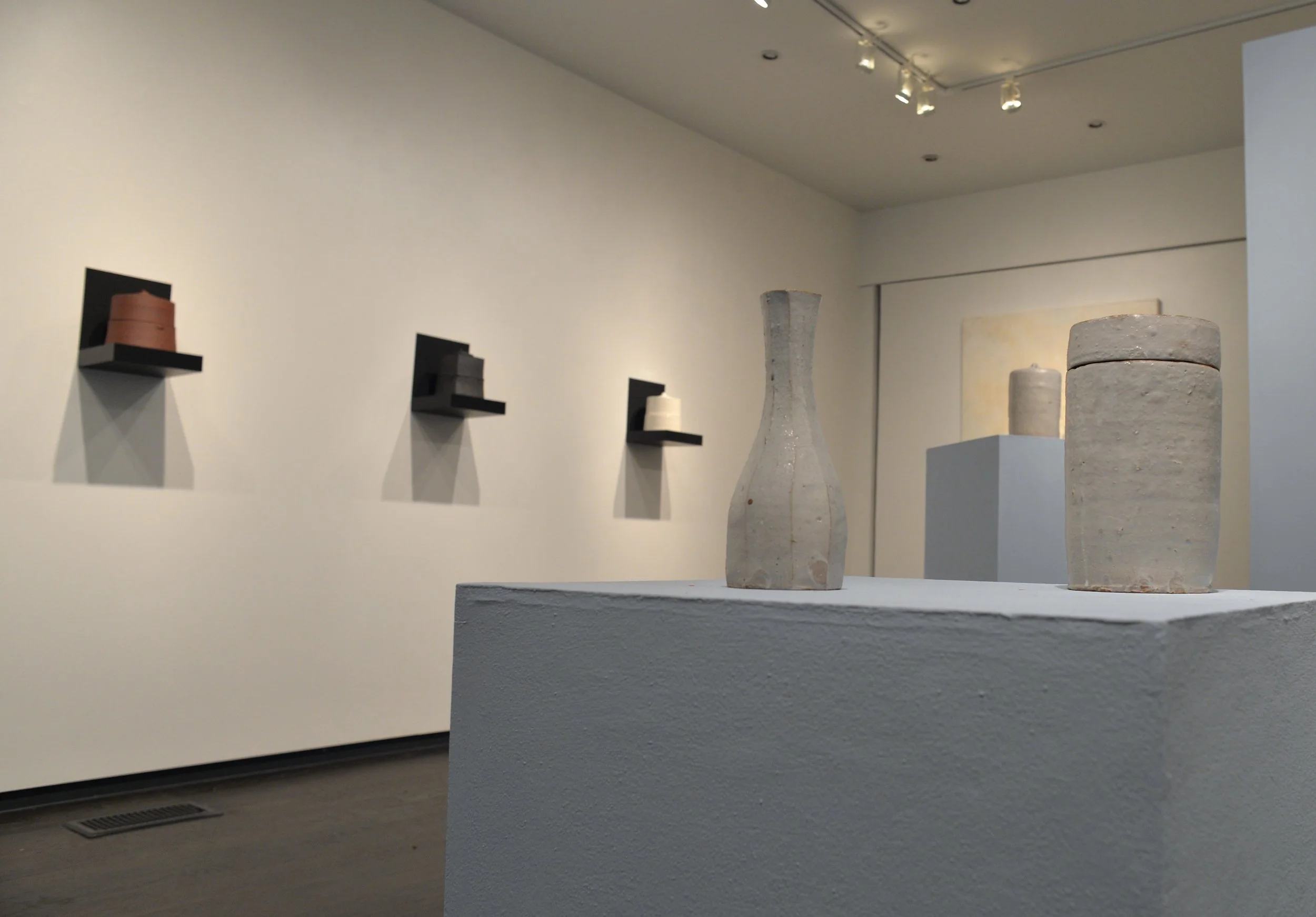
Your Custom Text Here
OPENING RECEPTION Friday, September 8th
Conversation with Julian Stair - Thursday, September 14th
Read the press in the Washington Post.
Cross MacKenzie Gallery is pleased to present Termini, a conversation on death, both symbolic and physical, featuring cinerary jars by Julian Stair, white ceramics by Rob Barnard, and works on paper by Rebecca Cross. The tactile minimalism of Stair and Barnard’s ceramics provoke a reverential contemplation on the solitude of death, while the graphic minimalism of Cross’s renderings of primeval weaponry display an objective curiosity about the harbingers of death. Historically, covered jars and weapons are emblematic of the passage into the hereafter, carrying remains and slaying adversaries; however, they are at the same time merely tools, utilized by disparate cultures around the globe is strikingly similar ways. Termini strips away the pomp and ceremony of death to lay bare the utilitarian tools that carry one into the afterlife.
Stair, the eminent British potter and historian of ceramics, has built a reputation around the world for his powerfully evocative vessels. A former studiomate of Edmund de Waal, the renowned potter and author of The Hare with the Amber Eyes, Stair’s work is similarly minimalist, using simple forms to great emotional effect, as in the full-size sarcophagi crafted for his Quietus exhibitions of 2012 and 2016. Stair’s reverence towards death is exceedingly evident through his work in Quietus, from which the cinerary jars on display in Termini were taken; using a variety of clays, from basalt to porcelain, Stair’s hand-thrown jars bask in the tactile immediacy of their materials, stripping away the garish adornments of modern urns to focus, instead, on the earth from which the clay came, and to which we all return. As a scholar, Stair’s essays have been featured in numerous publications, including Art in America and Ceramic Review, and will be part of the catalogue for the upcoming exhibition, Things of Beauty Growing, at the Yale Center for British Art, where his ceramics will also be showcased alongside those of Edmund de Waal and Felicity Ayelieff.
Barnard likewise emphasizes the physicality of the materials in his whiteware, allowing the white slip to form idiosyncratic cracks and drips instead of uniformly smooth surfaces. Another scholar of ceramics, Barnard has spent much of his career studying the traditional techniques of Japan. The choice of the color white for the slips is noteworthy, as white has historically connoted ideas of divinity and tranquility in eastern cultures, obliquely referencing the purity of death. Heavily influenced by his time working under the illustrious Yagi Kazuo, founder of the Sōdeisha movement in Japanese ceramics, Barnard’s work favors biomorphic sculptural characteristics in place of polished functionality. Currently based in western Virginia, this is Barnard’s first show with Cross MacKenzie Gallery.
Cross provides a stark contrast to the meditative ceramics of Stair and Barnard, with monochromatic drawings of ancient weaponry, from Indian war clubs to Fijian cannibal forks. Whether by illness, accident, or wittingly, the moment when a living organism suddenly transforms into cold matter is inherently violent. Cross’s works are unabashed contemplations of that transition, recalling one to the primal nature of death. The graphic abstraction of the weapons also recalls to the viewer that at the basest level, these are tools given purpose by individuals. Like the vessels of Stair and Barnard, Cross’s weapons are merely tools intended for use by a solitary person as part of the passage into the next world. Whether the objects are used upon the living or dead is irrelevant, as they are presented here as abstractions connoting the movement across planes of existence, not merely an act.
OPENING RECEPTION Friday, September 8th
Conversation with Julian Stair - Thursday, September 14th
Read the press in the Washington Post.
Cross MacKenzie Gallery is pleased to present Termini, a conversation on death, both symbolic and physical, featuring cinerary jars by Julian Stair, white ceramics by Rob Barnard, and works on paper by Rebecca Cross. The tactile minimalism of Stair and Barnard’s ceramics provoke a reverential contemplation on the solitude of death, while the graphic minimalism of Cross’s renderings of primeval weaponry display an objective curiosity about the harbingers of death. Historically, covered jars and weapons are emblematic of the passage into the hereafter, carrying remains and slaying adversaries; however, they are at the same time merely tools, utilized by disparate cultures around the globe is strikingly similar ways. Termini strips away the pomp and ceremony of death to lay bare the utilitarian tools that carry one into the afterlife.
Stair, the eminent British potter and historian of ceramics, has built a reputation around the world for his powerfully evocative vessels. A former studiomate of Edmund de Waal, the renowned potter and author of The Hare with the Amber Eyes, Stair’s work is similarly minimalist, using simple forms to great emotional effect, as in the full-size sarcophagi crafted for his Quietus exhibitions of 2012 and 2016. Stair’s reverence towards death is exceedingly evident through his work in Quietus, from which the cinerary jars on display in Termini were taken; using a variety of clays, from basalt to porcelain, Stair’s hand-thrown jars bask in the tactile immediacy of their materials, stripping away the garish adornments of modern urns to focus, instead, on the earth from which the clay came, and to which we all return. As a scholar, Stair’s essays have been featured in numerous publications, including Art in America and Ceramic Review, and will be part of the catalogue for the upcoming exhibition, Things of Beauty Growing, at the Yale Center for British Art, where his ceramics will also be showcased alongside those of Edmund de Waal and Felicity Ayelieff.
Barnard likewise emphasizes the physicality of the materials in his whiteware, allowing the white slip to form idiosyncratic cracks and drips instead of uniformly smooth surfaces. Another scholar of ceramics, Barnard has spent much of his career studying the traditional techniques of Japan. The choice of the color white for the slips is noteworthy, as white has historically connoted ideas of divinity and tranquility in eastern cultures, obliquely referencing the purity of death. Heavily influenced by his time working under the illustrious Yagi Kazuo, founder of the Sōdeisha movement in Japanese ceramics, Barnard’s work favors biomorphic sculptural characteristics in place of polished functionality. Currently based in western Virginia, this is Barnard’s first show with Cross MacKenzie Gallery.
Cross provides a stark contrast to the meditative ceramics of Stair and Barnard, with monochromatic drawings of ancient weaponry, from Indian war clubs to Fijian cannibal forks. Whether by illness, accident, or wittingly, the moment when a living organism suddenly transforms into cold matter is inherently violent. Cross’s works are unabashed contemplations of that transition, recalling one to the primal nature of death. The graphic abstraction of the weapons also recalls to the viewer that at the basest level, these are tools given purpose by individuals. Like the vessels of Stair and Barnard, Cross’s weapons are merely tools intended for use by a solitary person as part of the passage into the next world. Whether the objects are used upon the living or dead is irrelevant, as they are presented here as abstractions connoting the movement across planes of existence, not merely an act.